Our Shared Responsibility
Using less water, keeping rainwater on your property and managing what enters our storm sewer system means you are protecting both your home, the environment and saving money. Whether you live in a house, condo or apartment, find out what you can do in the different parts of your home.
The bathroom accounts for roughly 50% of your indoor water use. Learn how to check for leaky toilets, tips to save water, and what not to flush or pour down your drains.
Install Water Efficient Toilets & Fixtures
Save water and money by installing low- or dual-flush toilets (4.8 L or less), low-flow showerheads (under 7.6 L/min) and faucets (under 5.7 L/min) and faucet aerators.
Toilets Are Not for Trash
Items such as baby and other wipes (even those labelled flushable), dental floss, feminine hygiene products and cotton swabs belong in the waste basket. Return medications to the pharmacy. Learn more about what not to flush or pour down your drains.
Turn Off the Tap
When washing, brushing your teeth or shaving, never let the tap run continuously. Fill a glass with water to rinse your mouth when brushing your teeth. Rinse your razor by filling the bottom of the sink with a few centimetres of water.
Fix Leaky Faucets & Toilets
To check for a toilet leak, place a few drops of food colouring or dye test tablets (available at home improvement stores) in the toilet tank. Do not flush; wait 10-15 minutes. If the bowl water changes colour, you have a leak. You can contact a licensed plumber to help fix any leaks that you can not fix yourself.
Choose Non-toxic Cleaners
Protect your health and the environment by selecting environmentally-friendly cleaning products that are non-toxic and biodegradable.
Don’t Leave the Water Running
Keep a jug of drinking water in the fridge to always have cold water on hand. If washing dishes by hand, gather washed dishes on a rack and then rinse them with water or in a pan of clean water. If you have two sinks, partially fill one with soapy water and the other with rinse water. Defrost food in the fridge rather than under running water to save water and reduce foodborne illness risks.
Use the Dishwasher Wisely
Only run the dishwasher when it is full, and use the energy saver or shortest cycle. Pre-rinsing dishes is not necessary and uses up an extra 50L of water per dishwasher load.
Keep Cooking Fats, Oils and Grease Out of the Drain
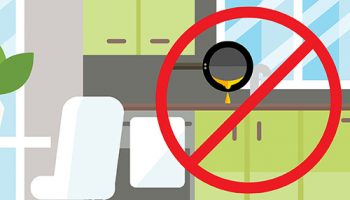
Fat, oil and grease can stick to and block the inside of pipes, which can lead to sewer back-ups and basement flooding. Let the grease cool and harden, and scrape it into the garbage.
Use a Faucet Aerator

Install a low flow aerator on your sink faucets to reduce your water use by up to 25%.
Insulate Drinking Water Pipes

Pipes that are not insulated are more susceptible to freezing, especially near outside walls and in crawlspaces, the attic and the garage. You can insulate your pipes by applying foam pipe covers available at home improvement stores Learn more about frozen pipe prevention.
Install a Backwater Valve to Prevent Sewer Back-Ups
 Install a backwater valve on your sanitary and/or storm sewer line to prevent water from backing up into your basement. Backwater valves need to be installed properly and regularly inspected and maintained.
Install a backwater valve on your sanitary and/or storm sewer line to prevent water from backing up into your basement. Backwater valves need to be installed properly and regularly inspected and maintained.
Wash Clothes Wisely
Use less water, electricity and detergent by purchasing a high-efficiency washing machine. To save even more, try to only do laundry when the machine is full. If you have to do smaller loads, be sure to adjust the water level on your washing machine to match the size of the load.
Collect & Pump Stormwater Away from the Basement
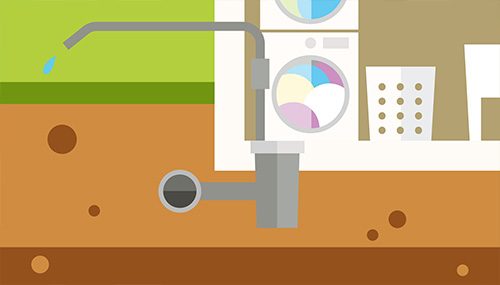
Foundation drains (also called weeping tiles) are pipes with holes that collect groundwater to keep it from entering your home. It is recommended that you connect the pipes to a sump pump to pump the water away from your foundation walls.
Use the Water Meter to Track Leaks

Suspect you have a leak? Turn off all indoor and outdoor water use and look at your water meter. If the small red triangle on the face of the meter is turning, you likely have a leak.
Know How to Turn Off Your Main Water Supply, In Case Your Pipes Burst
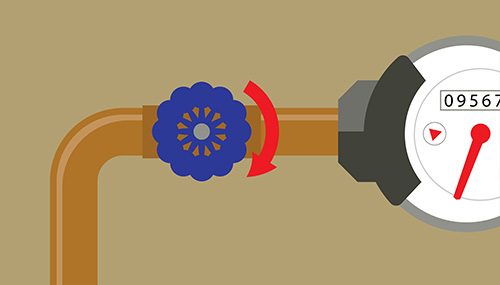
The main water shut-off valve is typically located on the foundation wall where the drinking water pipe enters your home. Locate and label it so you can easily find it. If going on vacation, you can protect your home from leaks or frozen pipes by turning off your main water supply and opening the taps to drain water from the plumbing.
Seal Cracks & Air Leaks
Stop rain and melted snow from entering your home by sealing cracks around windows, doors and in your foundation walls or floor. To keep your pipes from freezing, you should also seal air leaks around pipes, electrical wiring and dryer vents.
Ensure There is Water in Your Basement Floor Drain
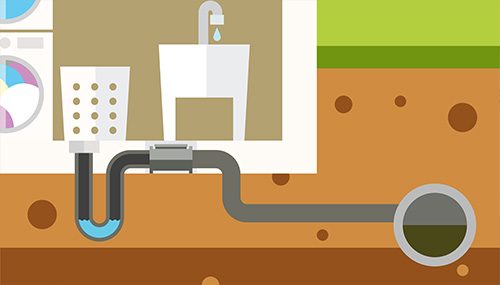
The pipe connected to your basement floor drain has a bump (called a P-trap) that retains water. This helps create a barrier, which prevents sewer odours from entering your home. In some homes, doing laundry or using the basement sink will refresh the water in the trap. If you smell a musty odour in your basement, check the floor drains and if dry, pour in a few litres of clean water.
Consider Water Efficient Plants, Trees and Vegetables
Native plants and trees are low maintenance and naturally drought-tolerant. Vegetables such as pole beans, swiss chard and rhubarb, and herbs such as rosemary, thyme and sage, also require minimal watering. When watering the garden, water deeply and less frequently. This minimizes losses to evaporation and improves the root system of plants. Consider adding mulch to the garden bed to significantly reduce the watering requirements of your plants.
Replace Hard Surfaces
Replace hard surfaces such as driveways, walkways and patios with porous paving, a garden or grass. This will help absorb and naturally filter rainwater and melted snow.
Maintain a Water Efficient Lawn
Healthy lawns only need 2.5 cm of water once a week, including rainfall. You can purchase a rain gauge, from a home hardware or building supply store, to keep track. Water in the morning to eliminate evaporation, and consider aerating in the spring or fall to help water reach the roots.
Ensure Landscaping Slopes Away From the Foundation
Ensure the grading around your home slopes away from the foundation wall to help drain water away from your home (without negatively affecting neighbouring properties).
Practice Responsible Car Washing
Take your car to a commercial car wash; find a location where the wastewater won’t flow into a catch basin. Or, use a bucket and small amount of water that can be emptied into a toilet or laundry sink.
Keep Chemicals Out of Drains & Sewers

Catch basins (the square grates on the road) drain straight to the lake, so it is important to keep chemicals and household waste out. Clean up vehicle spills or leaks to prevent toxins from entering the sewer. If you suspect a spill or illegal dumping, please contact the municipal office and report it to the water department.
Ensure Fire Hydrants are Clear

Fire hydrants must have at least 1.2 meters of space around them at all times. If you have a hydrant close to your property, please keep it clear of snow, trees and other vegetation.
Shut the Outdoor Water Supply Before the First Frost
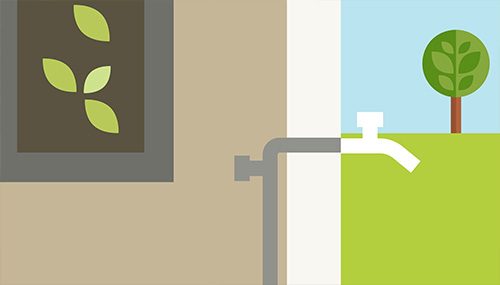
Outdoor pipes are the first to freeze. Before the first frost, unscrew the hose and close the valve that provides water to your outdoor water supply. This valve is located inside your home on the pipe that goes through the foundation and connects to your outdoor faucet.
Unplug Catchbasins
If it is safe to do so, clear roadside leaves and other debris from catchbasins to help water enter the storm sewer. Construction waste should also be kept out to prevent sewer back-ups and harm to local waterways.
Clear Eavestroughs & Downspouts
Clear eavestroughs and downspouts of leaves and other debris that prevent proper drainage.
Disconnect Your Downspouts

You are legally required to disconnect your downspouts from the municipal sewer system. Disconnect onto a permeable surface such as a garden or grass, 1.8 meters (6 feet) from your foundation.
Run a Water-Efficient Pool
Use a pool cover to conserve heat. The cover will also reduce the amount of water (and chemicals like chlorine) lost through evaporation.
Properly Dispose of Water from Pools, Hot Tubs & Spas
Since there are chemicals used in pools, hot tubs and spas, it is important you dispose of water properly at the end the of season, or before maintenance:
- Water from chlorinated pools must be dechlorinated before being emptied into the storm sewer (i.e. through a catch basin in front of your property).
- Water from salt water pools must be released into a sanitary system through a connection on your property (i.e. bathtub, laundry sink).
- Water from both chlorine and salt water pools can also be discharged onto grass, but only if it can be properly absorbed into the ground without flowing onto a neighbour’s property.

Water Pipes

The pipe that brings water into your home is called the water service pipe. If your home was built before the mid-1950s, you may have lead pipes, a soft metal that can enter drinking water and pose a health risk to some people.
Sewer Pipes

Sewer pipes carry wastewater (sewage). They are connected to a home’s plumbing (toilets, sinks, laundry, floor drain, etc.) and lead to a wastewater treatment plant.
Storm Sewer

A storm sewer collects stormwater from catch basins, connected downspouts and weeping tiles. It carries this untreated water into nearby streams, rivers and Lake Ontario.
Combined Sewer
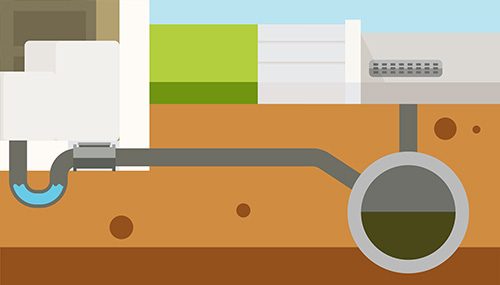
In some older parts of the city, stormwater and sewage are collected in the same pipe, known as a combined sewer. During normal weather conditions, all the wastewater in the combined sewer is treated at the wastewater treatment plant.



 Subscribe to this Page
Subscribe to this Page